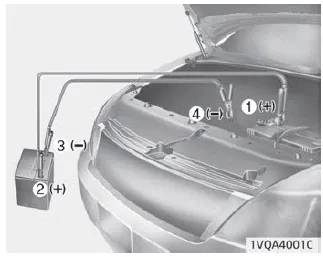Kia Soul (SK3): What to do in an emergency / Emergency starting

Connect cables in numerical order and disconnect in reverse order.
Jump starting
Jump starting can be dangerous if done incorrectly. Therefore, to avoid harm to yourself or damage to your vehicle or battery, follow the jump starting procedures. If in doubt, we strongly recommend that you have a competent technician or towing service jump start your vehicle.
CAUTION
Use only a 12-volt jumper system. You can damage a 12-volt starting motor, ignition system, and other electrical parts beyond repair by use of a 24- volt power supply (either two 12-volt batteries in series or a 24-volt motor generator set).
WARNING
Battery
Never attempt to check the electrolyte level of the battery as this may cause the battery to rupture or explode causing serious injury.
WARNING
Battery
- Keep all flames or sparks away from the battery. The battery produces hydrogen gas which may explode if exposed to flame or sparks. If these instructions are not followed exactly, serious personal injury and damage to the vehicle may occur! If you are not sure how to follow this procedure, seek qualified assistance. Automobile batteries contain sulfuric acid. This is poisonous and highly corrosive. When jump starting, wear protective glasses and be careful not to get acid on yourself, your clothing or on the vehicle.
- Do not attempt to jump start the vehicle if the discharged battery is frozen or if the electrolyte level is low; the battery may rupture or explode.
- Do not allow the (+) and (-) jumper cables to touch. It may cause sparks.
- The battery may rupture or explode when you jump start with a low or frozen battery.
Jump starting procedure
1. Make sure the booster battery is 12-volt and that its negative terminal is grounded.
2. If the booster battery is in another vehicle, do not allow the vehicles come in contact.
3. Turn off all unnecessary electrical loads.
4. Open the engine hood and remove the service cover on the front passenger seat side in the engine compartment.
5. Remove the fuse box cover on the front passenger seat side in the engine compartment
6. Open the positive terminal cap inside the engine room fuse box and the negative terminal cap close to the vehicle body.
7. Connect the jumper cables in the exact sequence shown in the illustration. First connect one end of a jumper cable to the positive terminal of the discharged battery (1), then connect the other end to the positive terminal on the booster battery (2).
Proceed to connect one end of the other jumper cable to the negative terminal of the booster battery (3), then the other end to a solid, stationary, metallic point (for example, the engine lifting bracket) away from the battery (4). Do not connect it to or near any part that moves when the engine is cranked. Do not allow the jumper cables to contact anything except the correct battery terminals or the correct ground. Do not lean over the battery when making connections.
CAUTION
Battery cables
Do not connect the jumper cable from the negative terminal of the booster battery to the negative terminal of the discharged battery. This can cause the discharged battery to overheat and crack, releasing battery acid.
Make sure to connect one end of the jumper cable to the negative terminal of the booster battery, and the other end to a metalic point, far away from the battery.
8. Start the engine of the vehicle with the booster battery and let it run at 2,000 rpm, then start the engine of the vehicle with the discharged battery.
If the cause of your battery discharging is not apparent, have the system checked by a professional workshop. Kia recommends to visit an authorised Kia dealer/service partner.
Push-starting
Your Manual Transmission-equipped vehicle should not be push-started because it might damage the emission control system. Vehicles equipped with Automatic Transmission/Dual Clutch Transmission/Intelligent Variable Transmission cannot be push-started. Follow the directions in this section for “Jump starting” on page 7-05.
WARNING
Never tow a vehicle to start it because the sudden surge forward when the engine starts could cause a collision with the tow vehicle.
If the engine doesn't turn over or turns over slowly 1. Check the battery connections to be sure they are clean and tight. 2. Turn on the interior light.
If your temperature gauge indicates overheating, you will experience a loss of power, or hear loud pinging or knocking, the engine is probably too hot.
Other information:
Kia Soul (SK3) 2020-2025 Owners Manual: Wheel replacement. Tire traction and maintenance
Wheel replacement When replacing the metal wheels for any reason, make sure the new wheels are equivalent to the original factory units in diameter, rim width and offset. WARNING A wheel that is not the correct size may adversely affect wheel and bearing life, braking and stopping abilities, handling characteristics, ground clearance, body
Kia Soul (SK3) 2020-2025 Owners Manual: Front fog lamp aiming
To aim the front fog lamp up or down, turn the driver clockwise or counterclockwise. Aiming point (Headlamp type A) Aiming point (Headlamp type B) Aiming point (Headlamp type C) Head lamp low beam (LHD Vehicle) 1. Turn the low beam on without driver aboard.
Categories
- Manuals Home
- Kia Soul Owners Manual
- Rear seat adjustment
- Seat
- Front seat adjustment - manual
- New on site
- Most important about car
